Passenger and Cargo Based Business Model for Enhanced Airport Mobility
VerifiedAdded on 2023/04/23
|5
|1341
|439
Report
AI Summary
This report examines the passenger and cargo-based business model, emphasizing its advantages in enhancing airport mobility and competitiveness. It highlights how this model helps airports attract airlines, improve service offerings, and ensure customer satisfaction. The report discusses the increasing pressure on airports to provide seamless journeys and the importance of adapting to the evolving demands of passengers and airlines. It explores how this business model facilitates better interaction between various stakeholders, including non-user stakeholders, aeronautical and non-aeronautical business units, and airlines, leading to improved service packages and operational efficiency. The report also addresses the impact of market liberalization and privatization on the airport industry, positioning the passenger and cargo model as a key strategy for success in the current competitive environment.
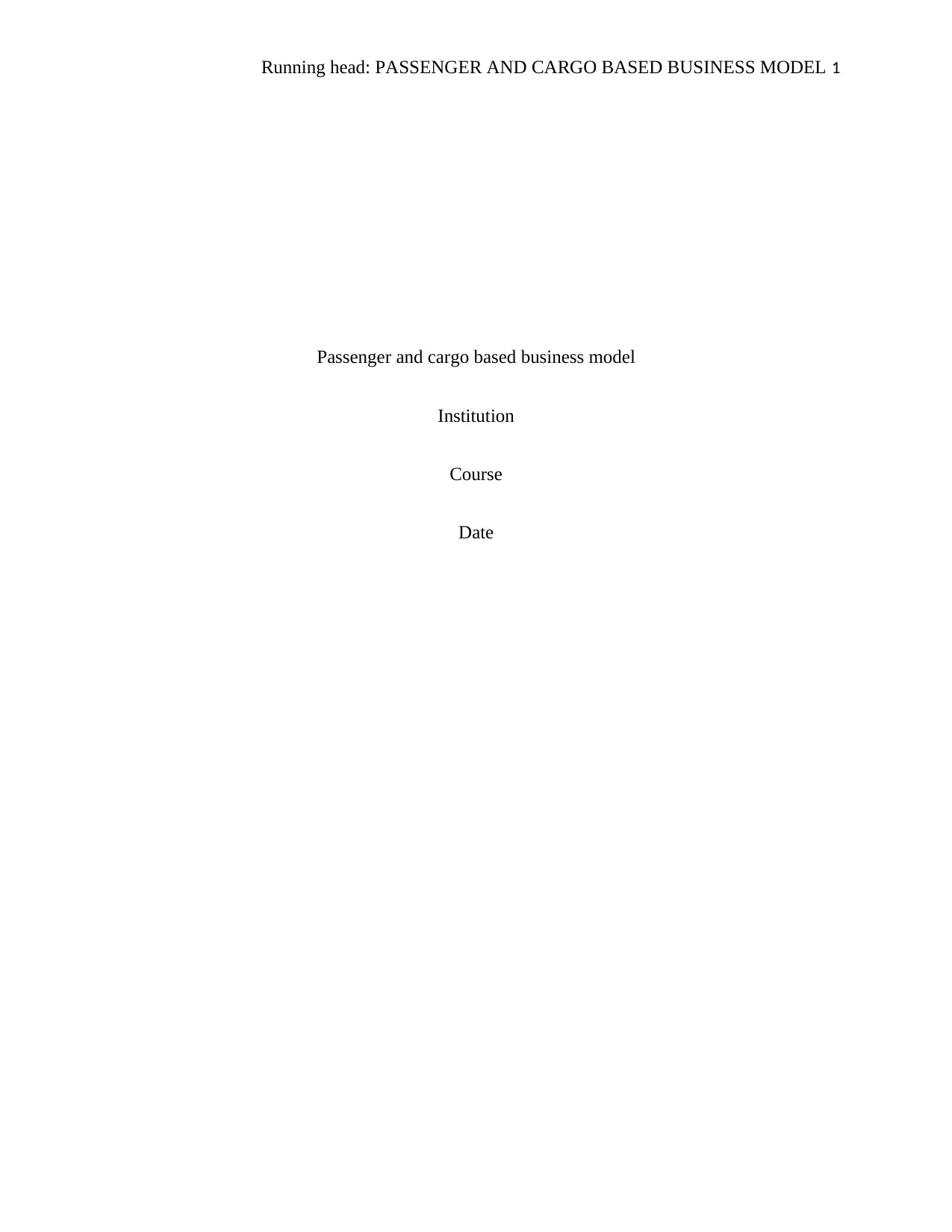
Running head: PASSENGER AND CARGO BASED BUSINESS MODEL 1
Passenger and cargo based business model
Institution
Course
Date
Passenger and cargo based business model
Institution
Course
Date
Paraphrase This Document
Need a fresh take? Get an instant paraphrase of this document with our AI Paraphraser
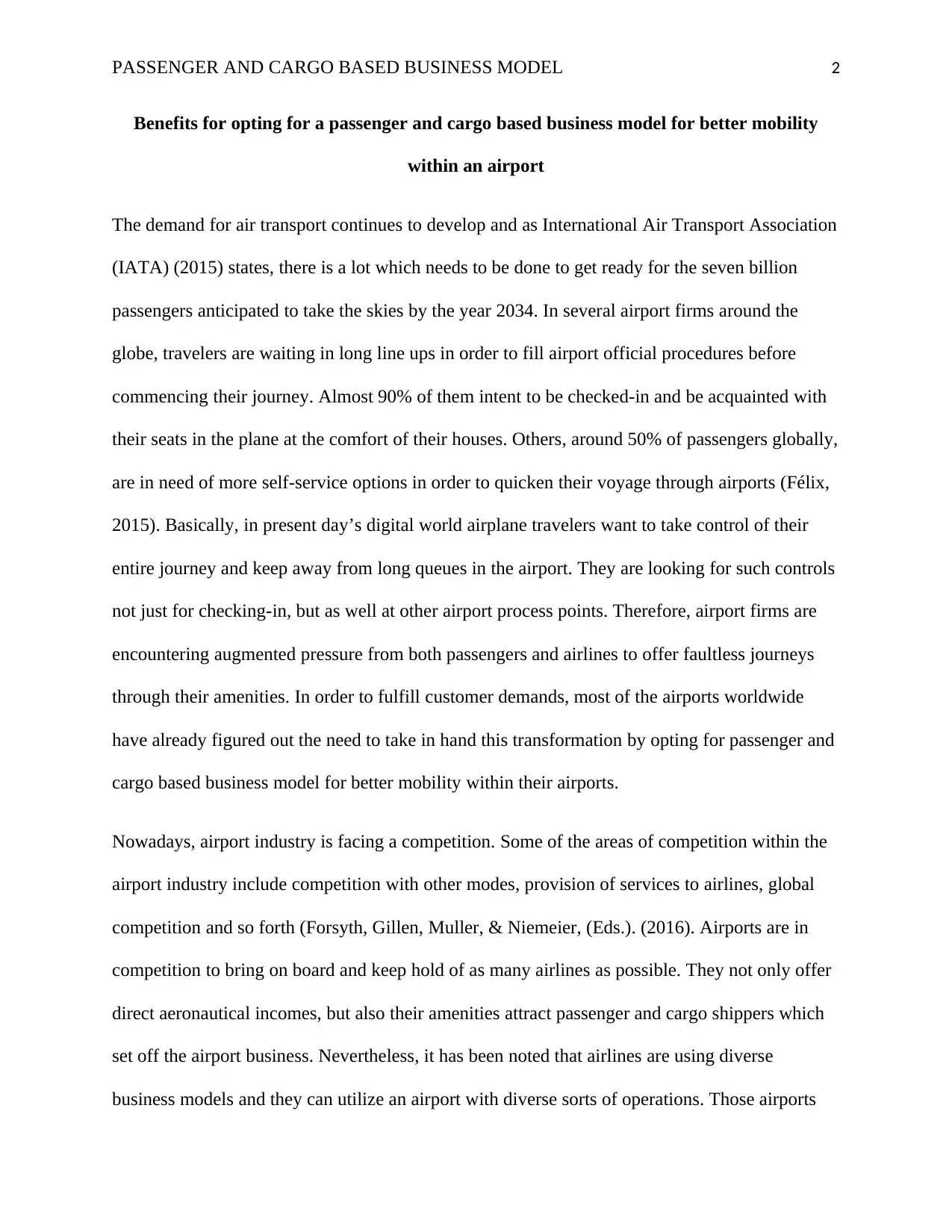
PASSENGER AND CARGO BASED BUSINESS MODEL 2
Benefits for opting for a passenger and cargo based business model for better mobility
within an airport
The demand for air transport continues to develop and as International Air Transport Association
(IATA) (2015) states, there is a lot which needs to be done to get ready for the seven billion
passengers anticipated to take the skies by the year 2034. In several airport firms around the
globe, travelers are waiting in long line ups in order to fill airport official procedures before
commencing their journey. Almost 90% of them intent to be checked-in and be acquainted with
their seats in the plane at the comfort of their houses. Others, around 50% of passengers globally,
are in need of more self-service options in order to quicken their voyage through airports (Félix,
2015). Basically, in present day’s digital world airplane travelers want to take control of their
entire journey and keep away from long queues in the airport. They are looking for such controls
not just for checking-in, but as well at other airport process points. Therefore, airport firms are
encountering augmented pressure from both passengers and airlines to offer faultless journeys
through their amenities. In order to fulfill customer demands, most of the airports worldwide
have already figured out the need to take in hand this transformation by opting for passenger and
cargo based business model for better mobility within their airports.
Nowadays, airport industry is facing a competition. Some of the areas of competition within the
airport industry include competition with other modes, provision of services to airlines, global
competition and so forth (Forsyth, Gillen, Muller, & Niemeier, (Eds.). (2016). Airports are in
competition to bring on board and keep hold of as many airlines as possible. They not only offer
direct aeronautical incomes, but also their amenities attract passenger and cargo shippers which
set off the airport business. Nevertheless, it has been noted that airlines are using diverse
business models and they can utilize an airport with diverse sorts of operations. Those airports
Benefits for opting for a passenger and cargo based business model for better mobility
within an airport
The demand for air transport continues to develop and as International Air Transport Association
(IATA) (2015) states, there is a lot which needs to be done to get ready for the seven billion
passengers anticipated to take the skies by the year 2034. In several airport firms around the
globe, travelers are waiting in long line ups in order to fill airport official procedures before
commencing their journey. Almost 90% of them intent to be checked-in and be acquainted with
their seats in the plane at the comfort of their houses. Others, around 50% of passengers globally,
are in need of more self-service options in order to quicken their voyage through airports (Félix,
2015). Basically, in present day’s digital world airplane travelers want to take control of their
entire journey and keep away from long queues in the airport. They are looking for such controls
not just for checking-in, but as well at other airport process points. Therefore, airport firms are
encountering augmented pressure from both passengers and airlines to offer faultless journeys
through their amenities. In order to fulfill customer demands, most of the airports worldwide
have already figured out the need to take in hand this transformation by opting for passenger and
cargo based business model for better mobility within their airports.
Nowadays, airport industry is facing a competition. Some of the areas of competition within the
airport industry include competition with other modes, provision of services to airlines, global
competition and so forth (Forsyth, Gillen, Muller, & Niemeier, (Eds.). (2016). Airports are in
competition to bring on board and keep hold of as many airlines as possible. They not only offer
direct aeronautical incomes, but also their amenities attract passenger and cargo shippers which
set off the airport business. Nevertheless, it has been noted that airlines are using diverse
business models and they can utilize an airport with diverse sorts of operations. Those airports
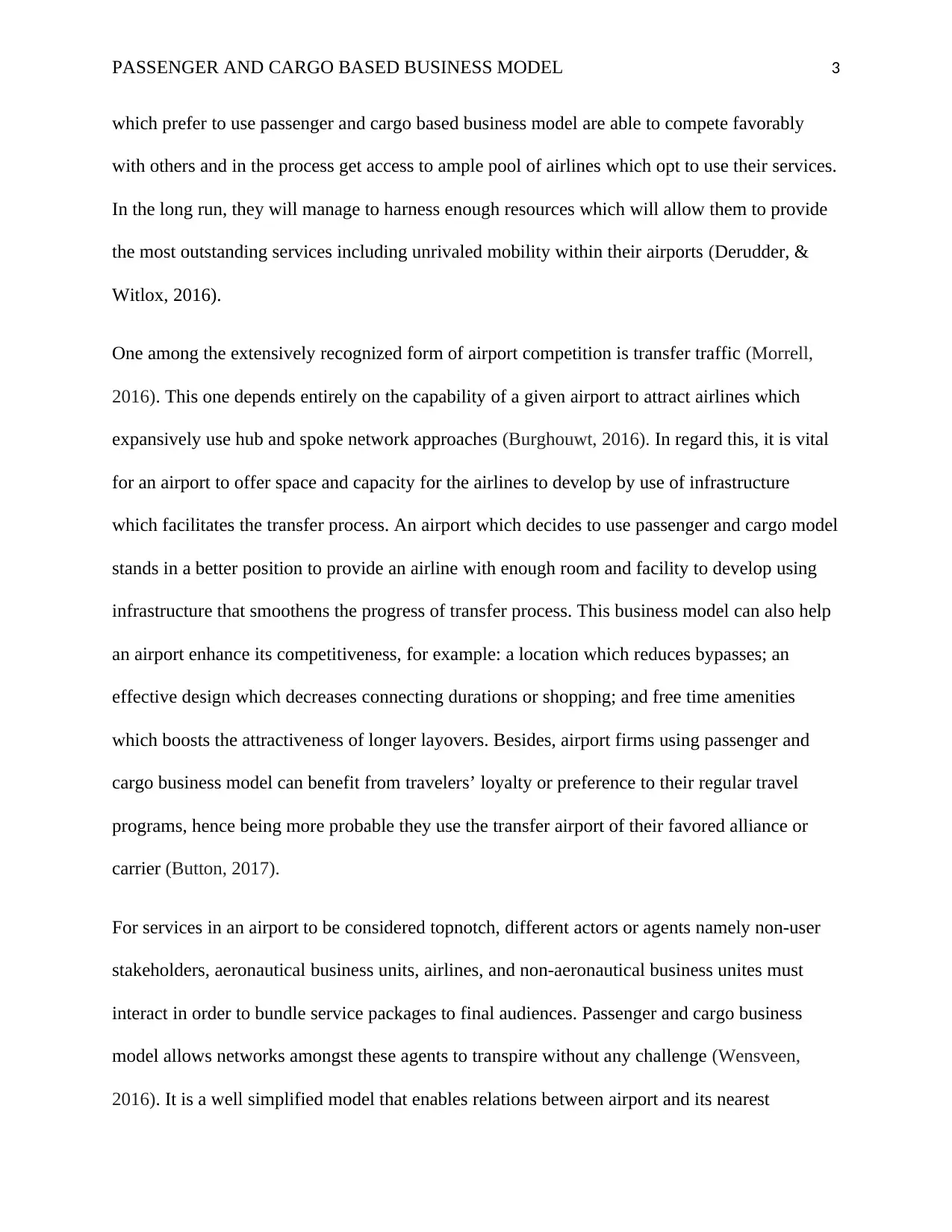
PASSENGER AND CARGO BASED BUSINESS MODEL 3
which prefer to use passenger and cargo based business model are able to compete favorably
with others and in the process get access to ample pool of airlines which opt to use their services.
In the long run, they will manage to harness enough resources which will allow them to provide
the most outstanding services including unrivaled mobility within their airports (Derudder, &
Witlox, 2016).
One among the extensively recognized form of airport competition is transfer traffic (Morrell,
2016). This one depends entirely on the capability of a given airport to attract airlines which
expansively use hub and spoke network approaches (Burghouwt, 2016). In regard this, it is vital
for an airport to offer space and capacity for the airlines to develop by use of infrastructure
which facilitates the transfer process. An airport which decides to use passenger and cargo model
stands in a better position to provide an airline with enough room and facility to develop using
infrastructure that smoothens the progress of transfer process. This business model can also help
an airport enhance its competitiveness, for example: a location which reduces bypasses; an
effective design which decreases connecting durations or shopping; and free time amenities
which boosts the attractiveness of longer layovers. Besides, airport firms using passenger and
cargo business model can benefit from travelers’ loyalty or preference to their regular travel
programs, hence being more probable they use the transfer airport of their favored alliance or
carrier (Button, 2017).
For services in an airport to be considered topnotch, different actors or agents namely non-user
stakeholders, aeronautical business units, airlines, and non-aeronautical business unites must
interact in order to bundle service packages to final audiences. Passenger and cargo business
model allows networks amongst these agents to transpire without any challenge (Wensveen,
2016). It is a well simplified model that enables relations between airport and its nearest
which prefer to use passenger and cargo based business model are able to compete favorably
with others and in the process get access to ample pool of airlines which opt to use their services.
In the long run, they will manage to harness enough resources which will allow them to provide
the most outstanding services including unrivaled mobility within their airports (Derudder, &
Witlox, 2016).
One among the extensively recognized form of airport competition is transfer traffic (Morrell,
2016). This one depends entirely on the capability of a given airport to attract airlines which
expansively use hub and spoke network approaches (Burghouwt, 2016). In regard this, it is vital
for an airport to offer space and capacity for the airlines to develop by use of infrastructure
which facilitates the transfer process. An airport which decides to use passenger and cargo model
stands in a better position to provide an airline with enough room and facility to develop using
infrastructure that smoothens the progress of transfer process. This business model can also help
an airport enhance its competitiveness, for example: a location which reduces bypasses; an
effective design which decreases connecting durations or shopping; and free time amenities
which boosts the attractiveness of longer layovers. Besides, airport firms using passenger and
cargo business model can benefit from travelers’ loyalty or preference to their regular travel
programs, hence being more probable they use the transfer airport of their favored alliance or
carrier (Button, 2017).
For services in an airport to be considered topnotch, different actors or agents namely non-user
stakeholders, aeronautical business units, airlines, and non-aeronautical business unites must
interact in order to bundle service packages to final audiences. Passenger and cargo business
model allows networks amongst these agents to transpire without any challenge (Wensveen,
2016). It is a well simplified model that enables relations between airport and its nearest
⊘ This is a preview!⊘
Do you want full access?
Subscribe today to unlock all pages.

Trusted by 1+ million students worldwide
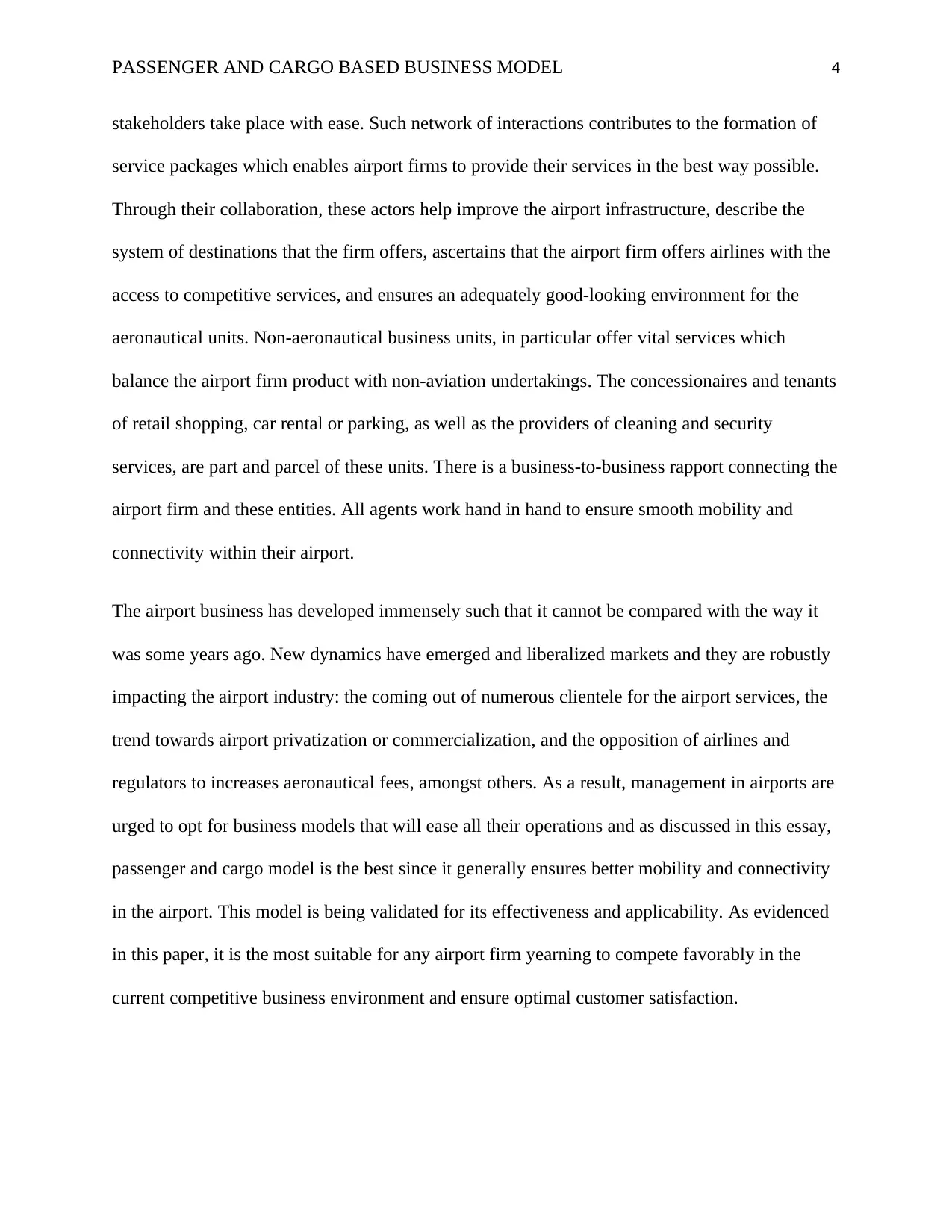
PASSENGER AND CARGO BASED BUSINESS MODEL 4
stakeholders take place with ease. Such network of interactions contributes to the formation of
service packages which enables airport firms to provide their services in the best way possible.
Through their collaboration, these actors help improve the airport infrastructure, describe the
system of destinations that the firm offers, ascertains that the airport firm offers airlines with the
access to competitive services, and ensures an adequately good-looking environment for the
aeronautical units. Non-aeronautical business units, in particular offer vital services which
balance the airport firm product with non-aviation undertakings. The concessionaires and tenants
of retail shopping, car rental or parking, as well as the providers of cleaning and security
services, are part and parcel of these units. There is a business-to-business rapport connecting the
airport firm and these entities. All agents work hand in hand to ensure smooth mobility and
connectivity within their airport.
The airport business has developed immensely such that it cannot be compared with the way it
was some years ago. New dynamics have emerged and liberalized markets and they are robustly
impacting the airport industry: the coming out of numerous clientele for the airport services, the
trend towards airport privatization or commercialization, and the opposition of airlines and
regulators to increases aeronautical fees, amongst others. As a result, management in airports are
urged to opt for business models that will ease all their operations and as discussed in this essay,
passenger and cargo model is the best since it generally ensures better mobility and connectivity
in the airport. This model is being validated for its effectiveness and applicability. As evidenced
in this paper, it is the most suitable for any airport firm yearning to compete favorably in the
current competitive business environment and ensure optimal customer satisfaction.
stakeholders take place with ease. Such network of interactions contributes to the formation of
service packages which enables airport firms to provide their services in the best way possible.
Through their collaboration, these actors help improve the airport infrastructure, describe the
system of destinations that the firm offers, ascertains that the airport firm offers airlines with the
access to competitive services, and ensures an adequately good-looking environment for the
aeronautical units. Non-aeronautical business units, in particular offer vital services which
balance the airport firm product with non-aviation undertakings. The concessionaires and tenants
of retail shopping, car rental or parking, as well as the providers of cleaning and security
services, are part and parcel of these units. There is a business-to-business rapport connecting the
airport firm and these entities. All agents work hand in hand to ensure smooth mobility and
connectivity within their airport.
The airport business has developed immensely such that it cannot be compared with the way it
was some years ago. New dynamics have emerged and liberalized markets and they are robustly
impacting the airport industry: the coming out of numerous clientele for the airport services, the
trend towards airport privatization or commercialization, and the opposition of airlines and
regulators to increases aeronautical fees, amongst others. As a result, management in airports are
urged to opt for business models that will ease all their operations and as discussed in this essay,
passenger and cargo model is the best since it generally ensures better mobility and connectivity
in the airport. This model is being validated for its effectiveness and applicability. As evidenced
in this paper, it is the most suitable for any airport firm yearning to compete favorably in the
current competitive business environment and ensure optimal customer satisfaction.
Paraphrase This Document
Need a fresh take? Get an instant paraphrase of this document with our AI Paraphraser
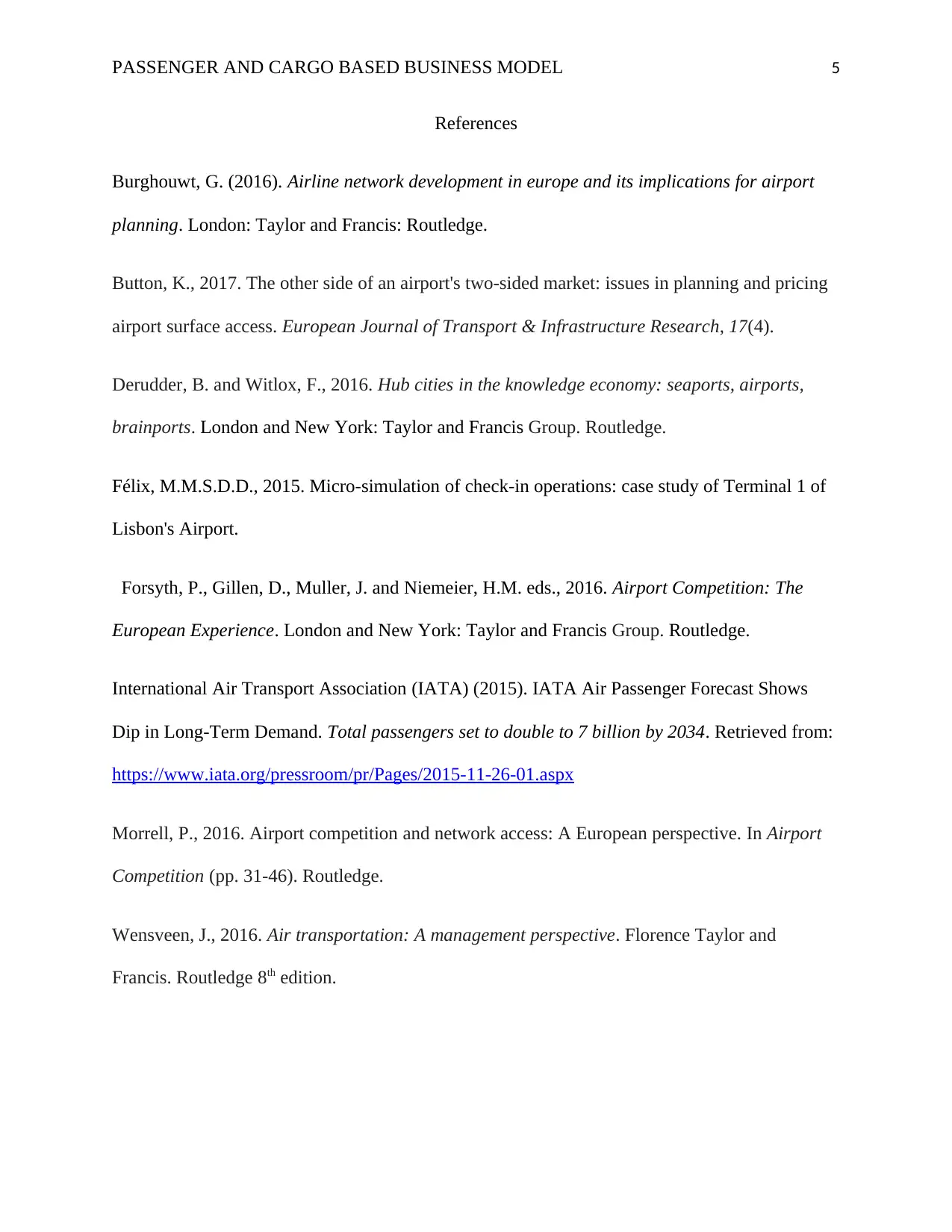
PASSENGER AND CARGO BASED BUSINESS MODEL 5
References
Burghouwt, G. (2016). Airline network development in europe and its implications for airport
planning. London: Taylor and Francis: Routledge.
Button, K., 2017. The other side of an airport's two-sided market: issues in planning and pricing
airport surface access. European Journal of Transport & Infrastructure Research, 17(4).
Derudder, B. and Witlox, F., 2016. Hub cities in the knowledge economy: seaports, airports,
brainports. London and New York: Taylor and Francis Group. Routledge.
Félix, M.M.S.D.D., 2015. Micro-simulation of check-in operations: case study of Terminal 1 of
Lisbon's Airport.
Forsyth, P., Gillen, D., Muller, J. and Niemeier, H.M. eds., 2016. Airport Competition: The
European Experience. London and New York: Taylor and Francis Group. Routledge.
International Air Transport Association (IATA) (2015). IATA Air Passenger Forecast Shows
Dip in Long-Term Demand. Total passengers set to double to 7 billion by 2034. Retrieved from:
https://www.iata.org/pressroom/pr/Pages/2015-11-26-01.aspx
Morrell, P., 2016. Airport competition and network access: A European perspective. In Airport
Competition (pp. 31-46). Routledge.
Wensveen, J., 2016. Air transportation: A management perspective. Florence Taylor and
Francis. Routledge 8th edition.
References
Burghouwt, G. (2016). Airline network development in europe and its implications for airport
planning. London: Taylor and Francis: Routledge.
Button, K., 2017. The other side of an airport's two-sided market: issues in planning and pricing
airport surface access. European Journal of Transport & Infrastructure Research, 17(4).
Derudder, B. and Witlox, F., 2016. Hub cities in the knowledge economy: seaports, airports,
brainports. London and New York: Taylor and Francis Group. Routledge.
Félix, M.M.S.D.D., 2015. Micro-simulation of check-in operations: case study of Terminal 1 of
Lisbon's Airport.
Forsyth, P., Gillen, D., Muller, J. and Niemeier, H.M. eds., 2016. Airport Competition: The
European Experience. London and New York: Taylor and Francis Group. Routledge.
International Air Transport Association (IATA) (2015). IATA Air Passenger Forecast Shows
Dip in Long-Term Demand. Total passengers set to double to 7 billion by 2034. Retrieved from:
https://www.iata.org/pressroom/pr/Pages/2015-11-26-01.aspx
Morrell, P., 2016. Airport competition and network access: A European perspective. In Airport
Competition (pp. 31-46). Routledge.
Wensveen, J., 2016. Air transportation: A management perspective. Florence Taylor and
Francis. Routledge 8th edition.
1 out of 5
Related Documents
Your All-in-One AI-Powered Toolkit for Academic Success.
+13062052269
info@desklib.com
Available 24*7 on WhatsApp / Email
![[object Object]](/_next/static/media/star-bottom.7253800d.svg)
Unlock your academic potential
Copyright © 2020–2025 A2Z Services. All Rights Reserved. Developed and managed by ZUCOL.




